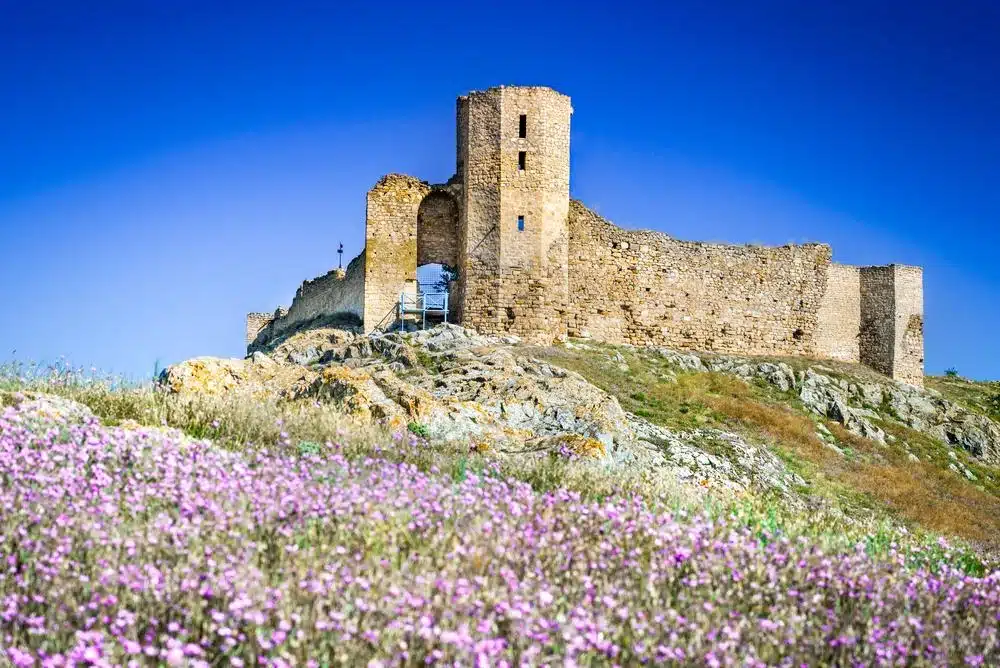Cuprins
Dobrogea’s fortresses, hidden from place to place, have interesting historical stories as well as evidence of the flourishing medieval activities that took place here. We invite you to discover the fortress of Enisala, a place once on the border between two distinct worlds: East and West.
- History of Enisala
- Enisala Fortress: features and curiosities
- What else to do in the area
History of Enisala
The fortress of Enisala attracts not only by the fact that it is perched on one of the high hills of Dobrogea (Dealul Gras), but also by its interesting history.
All the stories from Enisala recall the Genoese, who, at the end of the 13th, beginning of the 14th century, played a very important role in the historical evolution of Dobrogea. Before their arrival here, from the beginning of the 10th century, Dobrogea was a territory under extensive Byzantine influence. In fact, the Byzantines and the Genoese gave this region, where Enisala is now located, a special historical status, right where East and West met.
The Byzantine Empire allowed Genoese merchants to come and trade in Dobrogea, taking advantage of its openness to the Black Sea. It is said that even the Golden Horde (the heir state of the Mongol Empire) decided to make a pact with the Genoese, knowing that they could bring important benefits in terms of the development of trade in goods.
It was in this favorable context that the Genoese established colonies along the Black Sea, and it seems that they were the first builders of the fortress of Enisala.
Nowadays, Enisala Fortress is one of the best preserved fortifications in Dobrogea, and the only medieval fortress in this part of the country. In the following, you will learn about the peculiarities and curiosities of this place.
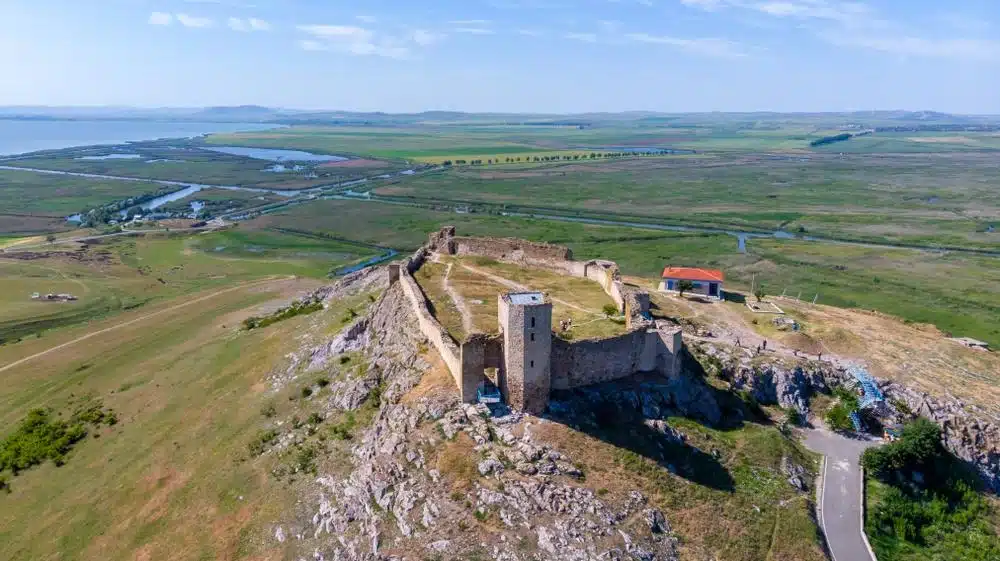
Aerial view of Enisala Fortress
Enisala Fortress: features and curiosities
The peculiarities of the Enisala Fortress are, as you will soon find out, interesting for the history of Dobrogea. Discover information and curiosities that will help you better understand the role and importance of this medieval fortress.
Where Enisala Fortress is located
Enisala Fortress is located in Sarichioi commune, Tulcea county, 10 km away from the fishing village of the same name.
The road access can be made either from the E87 Tulcea-Babadag and then on the DJ 223A, or from the DJ222, which connects the main fishing settlements in the Dobrogea area.
The road is paved all the way to the entrance to the citadel, and the car can be left in the designated parking areas or, depending on the traffic, in a traffic-free zone.
👉 Traveling to or from the airport? Simplify your trip and rent a car at great prices.
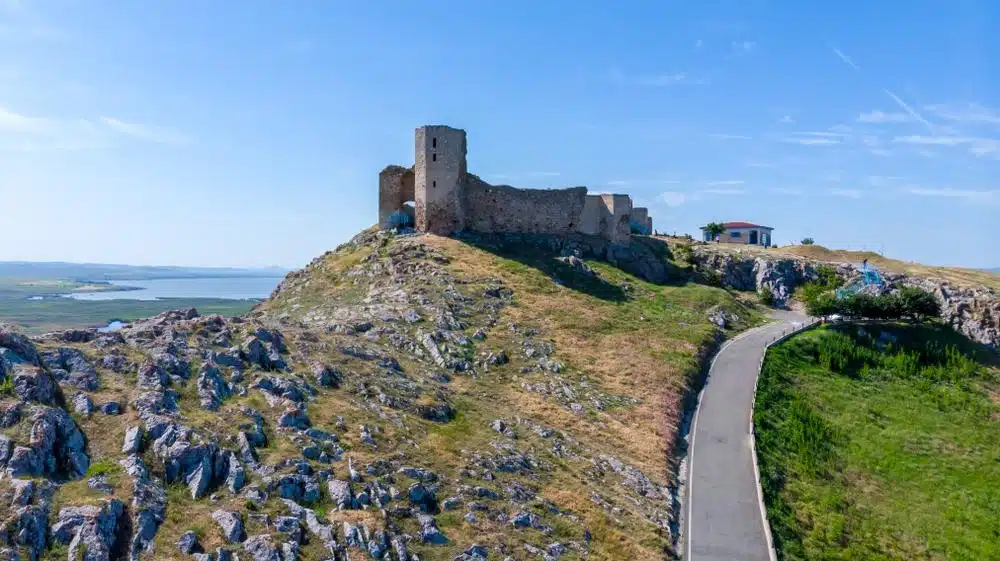
Access to Enisala Fortress
Yeni-Sale: the ancient border between East and West
Enisala was a fortress in the winds, influenced by its strategic position. Enisala Citadel was a border between East and West, this area of ancient Dobrogea being recognized for the merchants who came here from the two great geographical spaces.
A very important aspect, which allowed trade to develop, is that Lake Razim was a bay on the Black Sea. So Enisala was a port city.
Enisala was derived from the Turkish name “Yeni-Sale”, also recorded in the earliest historical document from the 15th century. “Yeni” meant “new” and “Sale” came from “settlement”. Thus Yeni-Sale translated as “new settlement”. Apart from this name, which has become the best known, Enisala was also referred to by other names, such as Heracleea (erroneously associated, some say, with Heracleea Pontica), Babola and Pampulo (in Genoese portulanies) or Eracri-Kupei (on Austrian military maps).
Between East and West, several fortresses and fortified settlements have sprung up, and Enisala stands out with several interesting features, which you’ll find out in a moment.
Enisala, a Genoese fortress built on a limestone hill
After much historical research and study, it has been established that the Enisala Fortress was built by the Genoese in the early 14th century. They had a monopoly on the Black Sea and controlled the flourishing trade that took place here.
Being wealthy merchants, they had the financial resources to build a settlement with a strategic and military role. At the time, they were the only ones interested in such a medieval construction. The hill chosen by the Genoese was a limestone one, over 110 meters high. This gave them a view of the Black Sea harbor.
Although there is another view that the fortress may have been built by the Tatars under the control of the Golden Horde, several historians validate that the fortress has Genoese origins. In addition to these aspects, researchers have established that there are similarities in the construction style of the Genoese-built Carsium Fortress (Harșova) and the enclosure wall of Constanța.
Archaeological research, dating back to the 1960s, shows that there are traces of habitation from the early Iron Age (Babadag culture). At the same time, the cemetery of the fortress was also identified, somewhere at the foot of the hill. So we are not only talking about a medieval settlement. At the same time, fragments of pottery specific to Roman settlement have been identified.
After the supremacy of the Genoese on the Black Sea, the fortress, under the rule of Mircea the Elder in the early 1400s, was also part of Walla Wallachia. From the conquest of the area by the Ottomans (1420) until the War of Independence (1877), Enisala was under their domination.
As the sand dunes separated Lake Razim from the Black Sea and the Ottomans advanced northwards into the Black Sea, interest in the fortress dwindled and eventually it was abandoned. Being abandoned and forgotten was somehow to the advantage of our country’s history. Historians mention that Enisala escaped the destruction of the Russo-Turkish wars precisely for this reason.
👉 The spectacle of nature in the Danube Delta is best admired from the water. There are therefore various boat trips available, depending on duration and preferences.
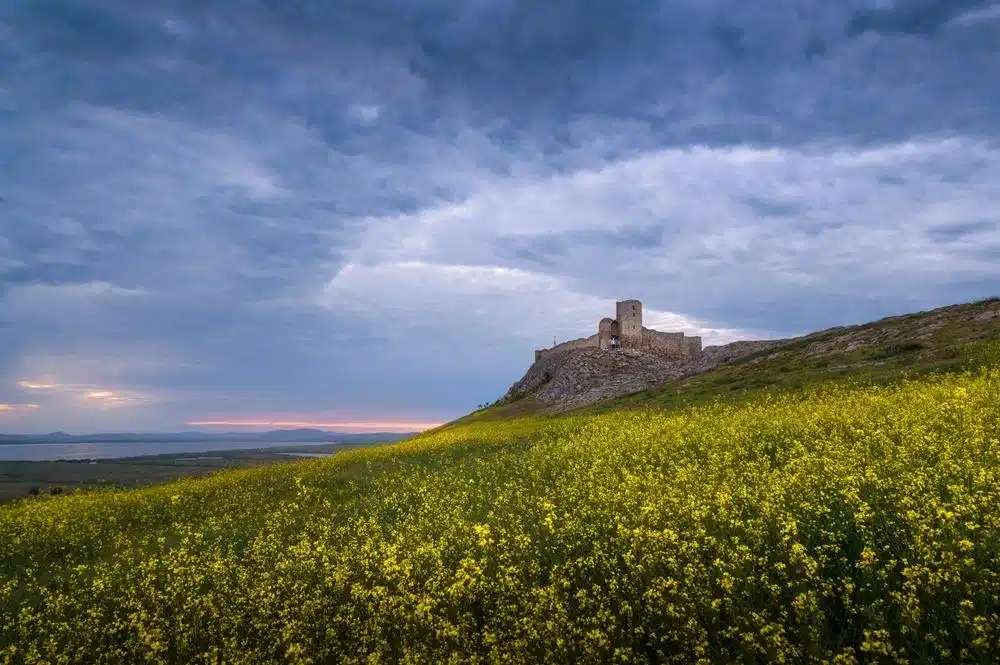
Enisala Fortress Landscape
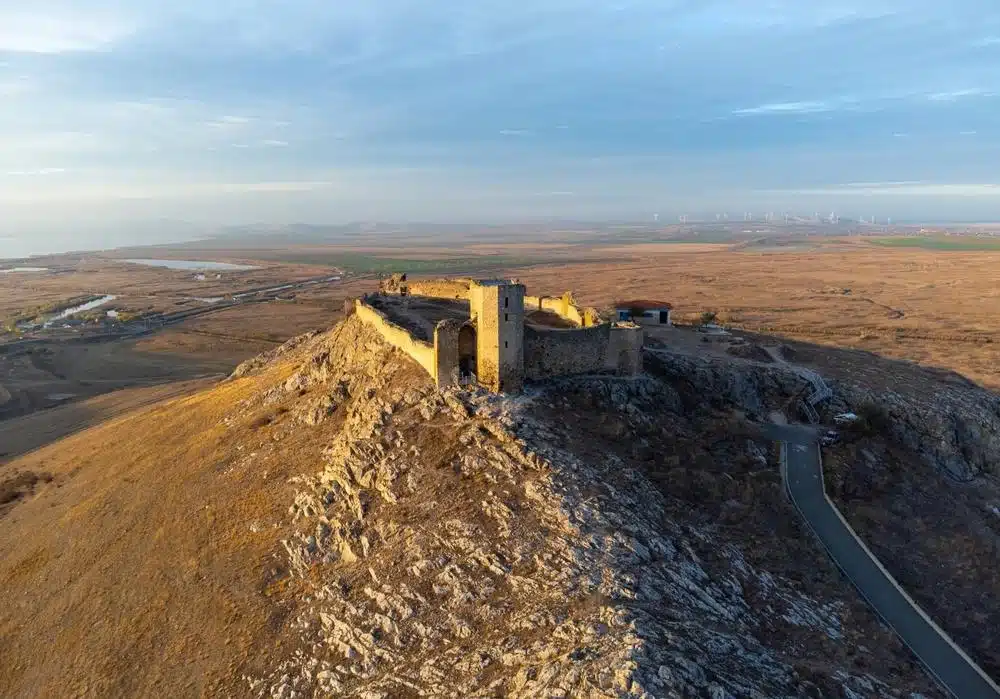
Enisala Fortress on the Fat Hill
Structure of Enisala Fortress
Enisala is a fortress with an irregular plan, which is due to the limestone massif on which the fortress was built. It was built with very lightly worked rocks and stones, arranged in regular building layers. A lime and sand-based mortar was used, with many shells in the composition.
High walls, once more than 5 meters high, although no longer complete, still surround the fortress of Enisala.
The bastion of the main gate is an important part of the fortress, which used to guard it. It has a hexagonal shape and was over 6 meters high. The construction style shows oriental influences. The entrance to the citadel is vaulted, with a Byzantine-style double arch.
Beyond this eye-catching bastion, the fortress still shows traces of lateral towers, set up to defend the enclosure. Parts of the courtyard and buttresses have partially survived. In the northern part of the fortress, the secondary access gate can also be seen.
The enclosure of the fortress is hollow, but the windows and vantage points are visible. Other interior elements have not survived. It is believed that the dwellings were built of stone and wood. Also the water cistern, which served the fortress, is still in the south-eastern part of the inner wall. It was plastered with mortar.
With this appearance and perched majestically on a limestone hill, the fortress has the appearance of a castle.
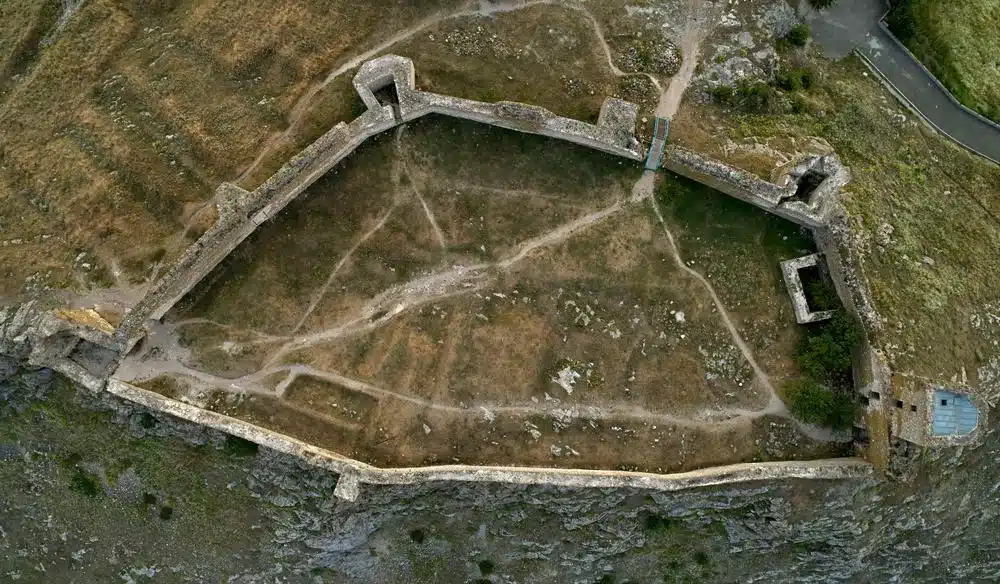
Structure of Enisala Fortress
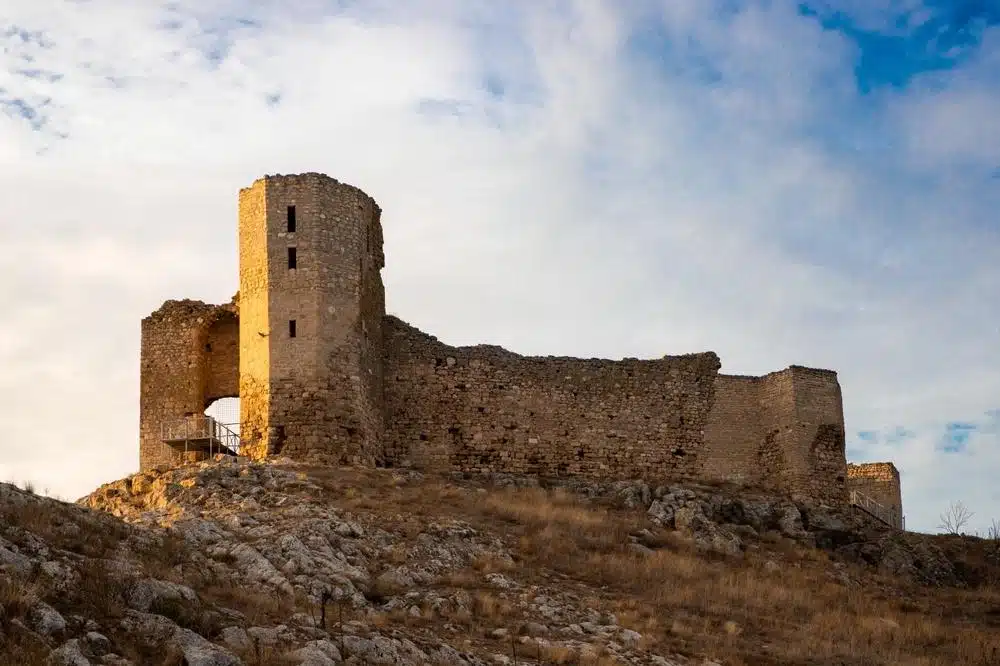
The walls of Enisala Fortress
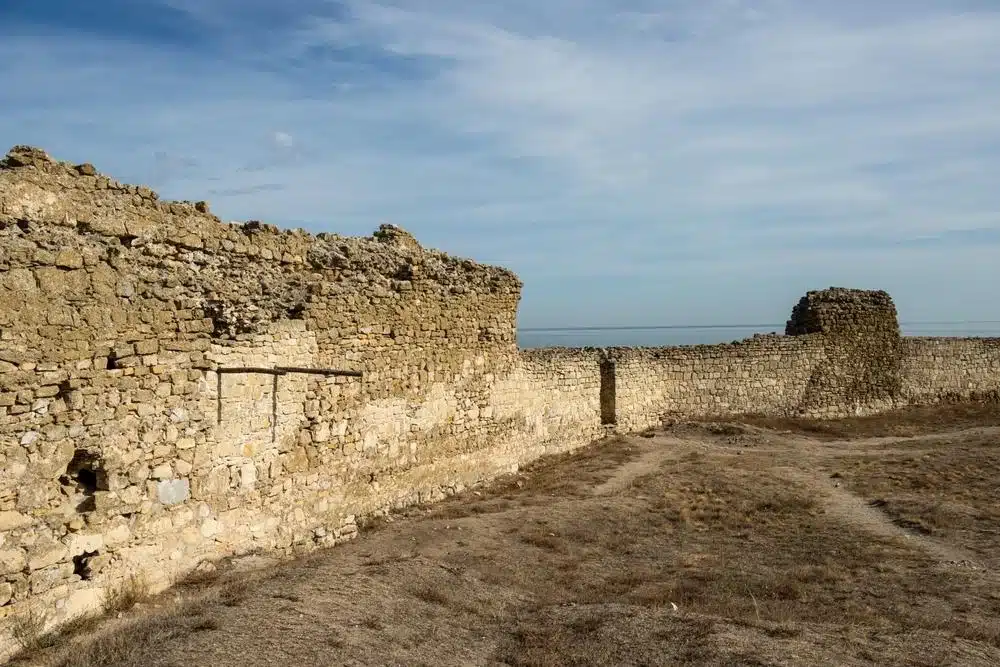
Inside Enisala Fortress
Enisala monetary inventory
An interesting feature of the Enisala Fortress is the monetary inventory discovered here. It covers a long period of time, thus several historical stages of great significance.
In short, there were found Genoese and Tatar coins, a coin belonging to the Golden Horde, Turkish coins, Bulgarian bronze coins, silver dinar, silver groats from the time of Peter Musat or silver ducats from the time of Mircea the Elder.
All these coins prove that the Enisala Fortress held, besides its strategic military function, an important political and economic status over the Dobrogea region.
Enisala Festival
The Enisala Festival – “Unity at the Citadel” – is a cultural event with all kinds of outdoor activities designed to recreate and entertain all visitors to the citadel.
From creative workshops, a live concert stage, local goodies fairs to an amusement park and a panoramic Ferris wheel, the Enisala festival has become one of the most important events in Tulcea.
The festival is usually held in the second half of August.
👉 The charm of a stay in nature is that you can enjoy it the way you want. By water or on land, discover the Danube Delta experiences!
Visiting Enisala Fortress
Enisala Fortress can be visited for a fee from Tuesday to Sunday between 10:00 and 18:00.
According to ICEM – “Gavrilă Simion” Institute of Eco-Museum Research “Gavrilă Simion” from Tulcea -, the price of a ticket is 12 lei/adult, respectively 6 lei/preschool, school, student or pensioner. The price also includes a short visit to the fortress museum.
What else to do in the area
In addition to visiting Enisala Fortress, you can also do some other interesting activities, depending on your preferences. For this, it is ideal to have a car with which you can quickly cover the road distances that connect the main sights and tourist attractions of this area of Dobrogea. Here are some recommendations of places you can consider:
Halmyris Fortress
If you want to discover other Dobrogea’s fortresses, you can continue your itinerary with the archaeological site of Halmyris. It is a Roman vestige, once a fortress-port on the Danube, located between the settlements of Murighiol and Dunavățu de Sus.
Although not as well preserved, the fortress of Halmyris had an important defensive role in Dobrogea, being built by Roman soldiers who established a Danubian fleet here.
Murighiol – Sf. Gheorghe
After a nice walk along the cliffs of Lake Murighiol, you can have an authentic fish lunch.
To get to Sf. Gheorghe, first take a fast boat from Murighiol.
In Sf. Gheorghe you have several activities you can do according to your preferences. For example, you can opt for a boat trip in the Danube Delta or a walk on the wild beach here.
👉 We look forward to welcoming you at Dolphin Camping, where we value nature and the facilities you need.
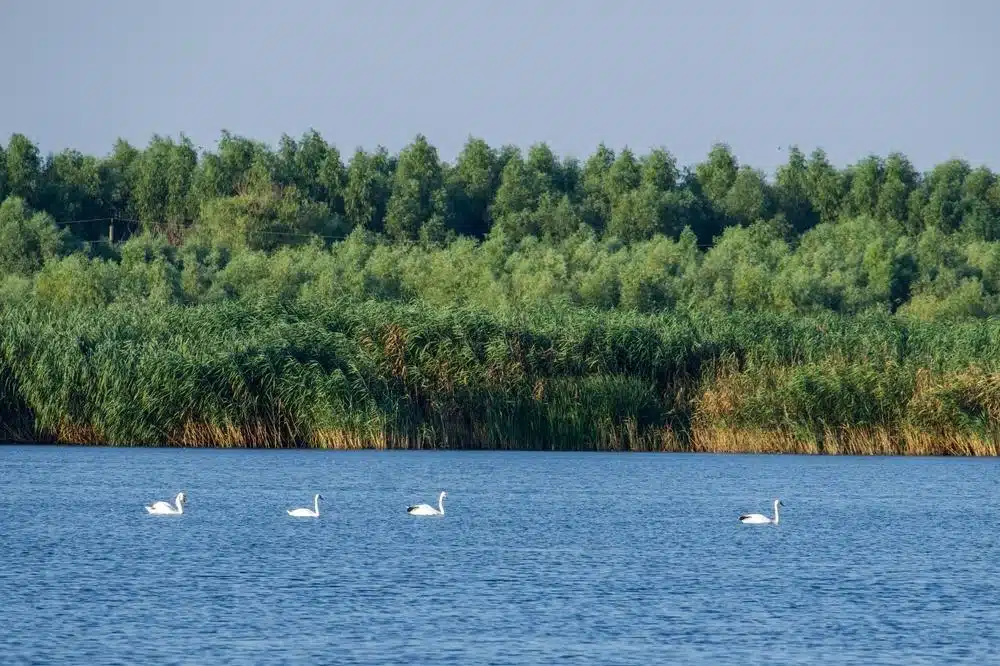
Lake Murighiol
Sarichioi
Sarichioi is one of the most beautiful fishing villages in the Dobrogea’s mainland.
With an outlet to the huge Lake Razim, Sarichioi has a small but very charming harbor. You can also take a stroll through the village to discover little Lipovene cottages, gilded church domes and locals willing to tell you interesting village stories.
Jurilovca – Gura Portiței
Jurilovca is a Lipovnian village with beautifully decorated traditional cottages colored in blue. The traditions of the Lipovans are still well preserved, so it’s well worth coming here and observing their way of life.
From Jurilovca you can take a boat to Gura Portiței – where the Danube and the Black Sea meet.
Chubby Head
If you don’t want to leave the dry land, the Chubby Cape is a must-see natural tourist attraction.
It is a rocky cliff, the only one in Romania. The view is very beautiful, including the expanse of water of Razim Lake and, a little further away, the Black Sea. You’ll also find the ruins of Argamum Fortress.
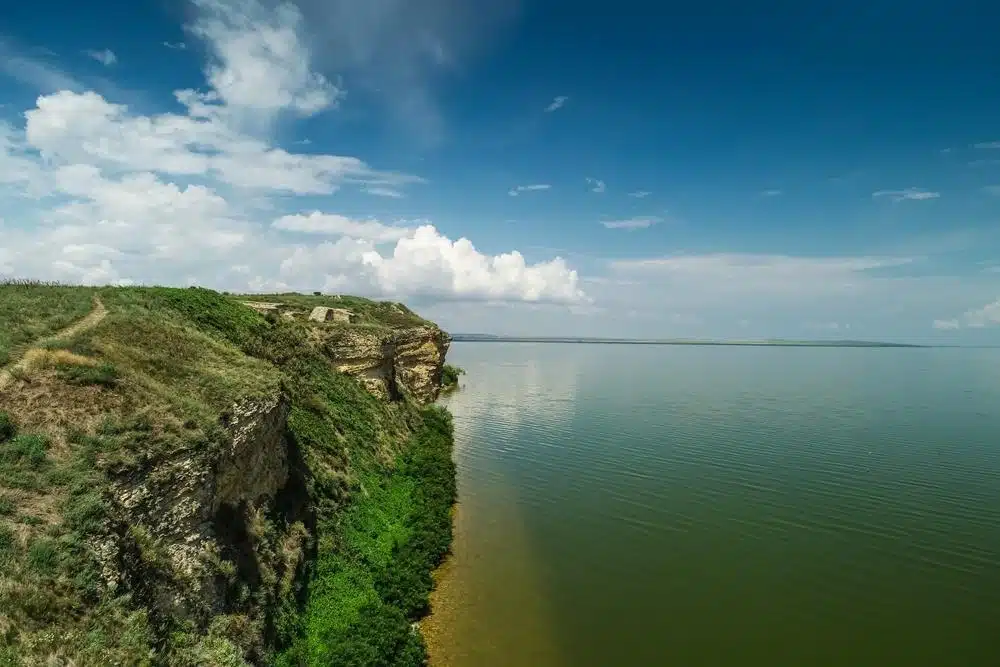
Chub Head - Razim Lake
Peony reserve
Another activity idea is to admire Dobrogea’s peonies in bloom. This takes place around May 15 every year.
A forest full of wild peony trees, transformed into a nature reserve, is waiting to be discovered just outside Enisala, near Babadag forest. Even if there are no road or tourist signs, you will find the place on Google Maps with the name “Enisala Peony Tree Reserve”.
The Enisala Fortress is an important tourist attraction of the area that you should put on your list. In addition to the interesting history you have just learned, you can enjoy a spectacular view of the vast expanses of water of Razim and Babadag lakes and the picturesque relief created by the hills of Dobrogea.
Photo Sources: Shutterstock, Shutterstock

